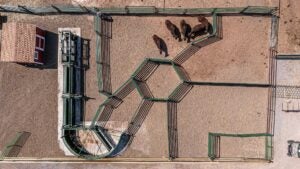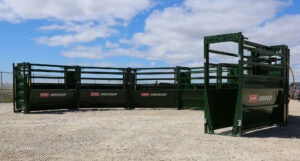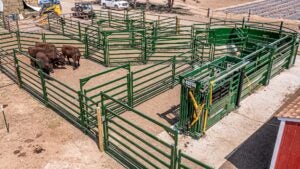When you’re working hard to build your legacy, having a safe cattle handling system should be one of your priorities. With the right cattle system design, the next generation can safely get involved, and you can minimize the risk of cattle getting loose or injuring not only themselves but you as well. There are many factors that go into creating the safest and most efficient cattle system, including the system components, location, breed of cattle, and amount of cattle.
Cattle handling systems have been around for a long time and have improved greatly over the years. Today’s systems are designed to significantly decrease the stress on livestock and handlers alike. Many ranchers place the most emphasis on the head gate and chute.
While they are important, a complete cattle handling system also includes holding pens, alleys, and gates. All these parts come together to create a system that is efficient and safe for your operation, but there are some things to consider when building your system.
1. Understand the difference between high- and low-pressure areas.
Cattle handling systems have both low-pressure and high-pressure areas, and it’s important you understand the difference to work cattle safely and efficiently. High-pressure can also be considered “high traffic” areas, such as the space that narrows to funnel cattle into the chute, around cattle gates, or any other area where livestock are more concentrated, and there is the potential for more stress to be put on them from handlers or the equipment. Low-pressure areas can include large holding pens where the cattle are not being asked to do anything or move in a certain direction.

2. Select the right correct corral panels for the job.
Corral panels can be divided into two general categories: lighter low-pressure, and heavier high-pressure. Low-pressure panels are ideal for holding pens and other less compact areas. It can be tempting to default to the lighter low-pressure corral panels because they are easier to carry and more economical, however, this can be dangerous.
If low-pressure panels are placed in high-pressure zones, you run the risk of cattle challenging the panels and getting loose, which may result in injury and broken equipment. Not to mention, the lifespan of these panels will also shorten due to wear and tear. Heavier panels are essential in high-pressure areas that work a lot of cattle, as they are built heavier-duty and can withstand even the rowdiest cattle while keeping you and your family safe.
3. Size matters.
The size of your herd directly influences the amount of pressure your cattle handling system faces. Higher-pressure areas tend to receive more wear and tear as the number of cattle worked in the system increases. An area that may be considered low-pressure on one operation may be considered high-pressure on another due to the number of animals.
Most of today’s cattle handling systems can be easily expanded with added corral panels and gates, allowing the system to grow alongside the operation. Connecting with a Livestock Expert and planning for this scenario when the system is designed is a helpful strategy.

4. Use design principles for low-stress cattle handling.
The design principles of a cattle handling system can make it easier and more natural to incorporate low-stress cattle handling. Dr. Temple Grandin of Colorado State University was the first to identify the principles of low-stress handling. Since then, various experts have documented these principles.
The first part of incorporating these handling principles is to use cattle behavior and animal science research to design a system that will draw the animal forward and encourage them to move swiftly through the handling system. This includes using curves instead of 90-degree corners, allowing more light to come through the system, and selecting equipment with quiet points such as rubber flooring to avoid scaring cattle.
5. Gate placement is crucial.
Cattle gates are the unsung heroes of the cattle handling system. They help ranchers adapt the facility to the task at hand or the size of the herd being worked. The general rule of thumb when it comes to gates is to add extra, even if you think they may be unnecessary. Eventually, they will be used and can serve as corral panels when not in use.
Bow gates are available for both high and low-pressure areas of a cattle handling system. A good quality bow gate will securely contain cattle and deter them from escaping with progressively spaced rails.

6. Design for flow.
Cattle flow is another area of research that Dr. Grandin pioneered and should be incorporated into every cattle system design. Proper cattle flow adheres to animal behavior and helps cattle naturally move through your system while maintaining a calm, yet forward momentum. Flow is important whether cattle are entering or exiting the system, and care should be taken when deciding where cattle go after the chute. It is also important to keep in mind you may need multiple exit options for your cattle if they need to be separated.
Cattle system design and setup are crucial to the success of any livestock operation. That is why, when designing your system, choose to work with a company that cares about the well-being of you and your herd. This includes companies that stand behind their equipment with an industry-leading warranty, 24/7 Client Care, and offer safety guarantees.
Though some system designs may seem like a heavy price tag up front, you can build it over time, and a well-designed system will be able to serve your operation for generations to come.
Say hello to safe, stress-free cattle handling with an Arrowquip system. Visit Arrowquip.com or connect with one of their experts at 1-866-383-7827.
This article was published on behalf of Arrowquip.


